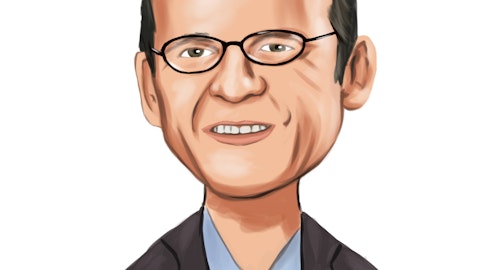Operator: Your next question comes from the line of John Roberts with Mizuho. Your line is open.
John Roberts: Thank you. I wanted to take advantage of having Sir Martin on the call. What do you think about the portfolio today? Are the non-electronic businesses generating enough cash for them to add value to the portfolio? And how do you think about additional acquisition opportunities in electronics?
Sir Martin Franklin: Well, thanks for the question. I think at the end of the day, we like to keep the portfolio as it is, and then we’re not any traders, we’re builders. So I think our mantra inside the business is always there isn’t an asset that couldn’t be better. But I think in different years, different parts of the business perform better than other years. So I think we have a very strong portfolio and we tend to invest and try to grow each part. In terms of M&A, we’ve been opportunistic. I mean, the acquisitions that we’ve made have been longer term in nature in terms of their potential, and I think they’ve set the foundation for stronger organic growth for the company in future years. And from the [indiscernible] acquisitions and I think the M&A environment has become like the windows open again.
But as you heard from Ben Gliklich’s comments, the cash flows in the business are strong and we’ll have the capability to do things if the right opportunities avail themselves.
John Roberts: Thank you. And then Ben, is the benefit of new electronics in autos still small enough that it gets offset when there’s a slowdown in overall ICE vehicle production or how do we think about the balance between the exposure to the secular growth areas of autos versus the cyclical exposure?
Ben Gliklich: Yes, so if you look at our assembly business in 2023, it significantly outperformed our circuitry and semiconductor businesses, and that was largely driven by strength in automotive. So not only are we seeing uplift in content, but we’re seeing innovation that our business is bringing to bear to that market and high reliability alloys that’s driving share and outperformance even in the auto markets. Again, it depends on the magnitude of automotive production declines to answer that question accurately, but we are seeing a low-single digit uplift in content per unit each year. That’s even greater as electric vehicle penetration increases and our performance in power electronics has been outstanding and that’s a segment of the market and technology that has been growing really, really nicely and will continue to for several years to come.
John Roberts: Thank you.
Operator: Your next question comes from the line of Steve Byrne with Bank of America. Your line is open.
Steve Byrne: Yes, thanks. Ben, your guide sounds like it’s primarily driven by macro factors. I’m just curious whether that $510 million to $530 million EBITDA incorporates any expectations for end market restocking, not just your customer, but your customers’ customers. Any potential for share gains, cross-selling or pricing power? Are any of those in your outlook? And if not, what’s the potential for it?
Ben Gliklich: Sure. Thank you. So over the past several years, that the going in assumptions for market performance have been way off relative to the back half performance that was realized and so we have to draw a line based on industry forecasts and that’s how we’ve formulated our guide. There is room for outperformance from an end market perspective as we think about upsides and downsides. Our performance, again organic on a like-for-like basis in the mid-teens from an EBITDA growth perspective, is quite a ways higher than market forecast. And so there is a benefit from margin improvement that we’ve seen carrying over outperformance relative to end markets on the top line and mix where new technologies that we’re introducing into the business are gaining share. We’ve also held price and the benefit of that execution is accruing to shareholders in the guide.
Steve Byrne: And with respect to this $15 million increase in comp, do you have any productivity initiatives that might potentially offset it?
Carey Dorman: Yes. So we have been investing in site consolidation and systems modernization. We have streamlined the organization from a leadership perspective over the past year, and so there are savings built into the plan that offset some of that, but not all. And the incremental margins again, are in the 30s, inclusive of that comp rebuild, and in the 40s, which is above what we target in a normal year, exclusive of it. So we feel as though there is good efficiency being driven through the business and operating leverage.
Steve Byrne: Okay, thank you.
Operator: Your next question comes from the line of Jonathan Tanwanteng with CJS Securities. Your line is open.
Jonathan Tanwanteng: Hi, good morning. Thanks for taking my questions. I was wondering if you could dive a little bit more into your on power electronics and investments in the EV realm. And is that oriented more towards any particular technology like silicon carbide or is it targeted more towards Pure EV, can it be applied to hybrids, or do you have any exposure to any particular player or partner? Just any more detail there will be helpful. Thank you.
Ben Gliklich: Sure. So our power electronics business provides really differentiated material used in the assembly of power semiconductors and then power inverters. Very strong market position within certain OEMs that are Pure EVs. The opportunity there is for growth in those OEMs and also penetration of, let’s call them OEMs that have longer cycle times to develop new platforms. And so we are not on every OEM’s electric vehicle platforms, and there’s no reason that this material shouldn’t be on all of the high performing electric vehicles in the market. We’ve been investing in applications, labs, not just in the west, but we opened one in Shanghai last year. And we’ve had great traction with the Chinese electric vehicle OEMs. There’s a lot of market opportunity for this, both as EV units grow and as our penetration of EV OEMs expands. It’s an exciting technology for us.
Jonathan Tanwanteng: Got it. Thank you. And then just a question for Carey. Where does the SG&A start the year as you layer the bonus accrual back in?


